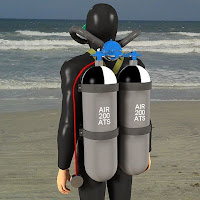 |
| Aqua-lung |
The lungs do not have enough capacity to expand when the water pressure increases rapidly with depth: at 10 meters it is 2 atmospheres (2 kg/cm²).
In order for a submerged diver to breathe, he must receive air at the same pressure as the surrounding water. This is achieved with aqua-lung. The air is stored at high pressure - up to 200 atmospheres - in tanks that are carried on the back, from which a tube connected to a nozzle comes out.
The air reaches the diver through a two-stage regulator. First the pressure is reduced to about 10 atmospheres above the water pressure. The nozzle then supplies air at the same pressure as the secondary water.
The nozzle has a flexible nozzle open to the water on one side and to an air chamber on the other.
The moment the diver inhales, he pulls in the diaphragm, which in turn presses a lever inside the chamber. This opens a valve that lets air in from the tube, where the pressure drops.
When the diver stops inhaling, the opposite happens: the air that reaches the chamber pushes the diaphragm, closes the valve and cuts off the air flow.
Even if the diver does not inhale, the increase in water pressure as it drops pushes the diaphragm forward to open the valve and then let air through the tube.
In this way, the air in the chamber is always maintained at the same pressure as the surrounding water.
.